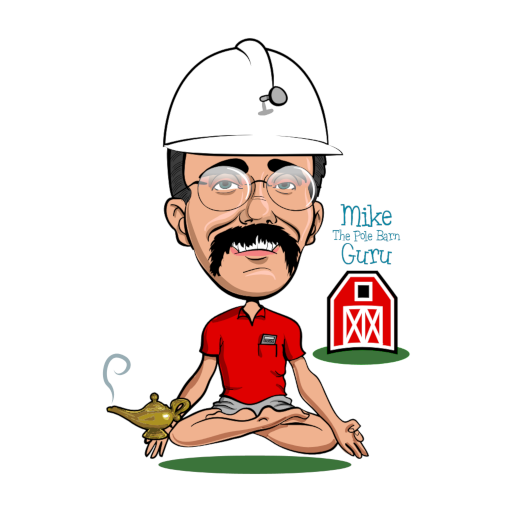About a decade ago my bride took a phone call from a potential pole barn purchaser. The female caller identified herself and then said despairingly, “My husband wants me to live in a pole barn house…and I don’t want to live in a barn!”
Unfortunately the level of her panic told my wife this caller really had no clue as to what a pole building could “be”. My wife got off the phone, turned in her chair and stated to me “we need to build a barn.” Now I am more than happy to accommodate my lovely bride, but to have her suddenly declare she wanted to “build a barn” definitely got my attention.
 As it turned out, she wanted to build a pole barn house. She wanted the traditional “barn style”, which is called a gambrel, and to finish it “just like a house”. To make a long story short – we did just that. The main part of the building is 48’ x 60’ with two 18’ enclosed sheds. I dropped one of them back a bit from the front end wall to create more of a residential “look” and make it more stylish.
As it turned out, she wanted to build a pole barn house. She wanted the traditional “barn style”, which is called a gambrel, and to finish it “just like a house”. To make a long story short – we did just that. The main part of the building is 48’ x 60’ with two 18’ enclosed sheds. I dropped one of them back a bit from the front end wall to create more of a residential “look” and make it more stylish.
Center of the downstairs houses vehicles, a huge hot tub, a vintage pickup and two huge boats. One of the side sheds is a deluxe office space, with custom cabinets and built in desks.
Upstairs has a large bedroom and master bath walled off, with a circular stairway up to a loft for my wife’s sewing room. The living room is huge, with vaulted ceilings and room for a pool table, desk/office space plus a dining area. Both the bedroom and living room have gas fireplaces.
My wife calls her pole barn house her “home fit for a queen”. I do believe she just may be right!
I’ve noticed post frame building (the caller’s “pole barn”) becoming more popular over the past several years. Having personal experience, I can relay from the trenches.
The resultant of my wife’s conversation was we decided to use post frame construction to construct a building which could be used residentially. We also felt post frame offered advantages which no other form of construction could.
Here are the Good, the Bad and the ugly of our over 8,000 square foot post frame building:
UGLY
Even though I truly understand post frame construction, I appreciate Building Departments which actually perform structural plan reviews and field inspections. Where the building is located, for the price of an average Domino’s® Pizza order, one can obtain a Building Permit – with no inspections!
The HVAC system – it is also Good….until it needs to be serviced, as it is nearly impossible to find a contractor who is knowledgeable and will travel to 90 miles South of Fargo.
We ordered Traco triple glazed Low-E argon vinyl windows of various sizes, styles and dimensions, including a series of 10 which make an arch 24 feet wide and 12 feet tall. One of the selling points by wholesaler Guardian Building Products was the lifetime warranty. Only after the windows began failing (including one which literally fell out of the vinyl) did I find Traco had sold their vinyl line and my warranty was worthless.
BAD
We had to get a variance as an accessory building in this particular jurisdiction was limited to a 10 foot eave. My wife convinced them of just how impractical the limitation was, and they stamped her request as “approved”.
At times Building Contractors tend to “go their own way” – and ours was no different. We ended up with stairs so steep they never would meet Code, yet there would have been plenty of room for them to have been done right.
The elevator. Yes, elevator. My wife told me she wasn’t going to hike up a 20 foot rise of stairs forever. The pneumatic elevator is a nifty idea, and it is fabulous when it runs. It does require some adjusting from time to time to keep it operating.
GOOD
The building is on an ideal site on a lot of over two acres. The land to the North is owned by the State of Dakota for a game refuge and to the South, one can see six miles up Lake Traverse to Browns Valley, MN.
The building uses geothermal wells as part of the HVAC system. A series of 275 foot deep wells are incorporated in it. Once past the sticker shock of the system, it is very cost effective. We were told it would take 24 hours to get building up to temperature, however it is closer to four to six hours.
Dale and Tom from Timber Technologies provided glu-laminated Titan Timbers as long as 50 feet in four ply 2×8 for the overall height of 44 feet above grade. After they were placed and concreted in we had some 60 miles per hour winds. The tops of the columns reminded me of watching the Tameracks near our Spokane, WA area home which bend in the wind, but never break.
This building is gambrel (barn) style. The center portion has a 20 foot tall eave, and is 48 feet wide. The roof pitch break is eight feet from each side horizontally and 16 feet vertically. The upper portion of the roof has a 6/12 roof slope. The center portion has clear span wood parallel chord floor trusses which are 44 inches thick. From top of slab to ceiling in this 48 by 60 area is 16 feet. It was designed to be a one-half court basketball court. Above this are gambrel trusses with a 16 foot ceiling height – the inside slope of the gambrel is 12/12 which makes for some unique interior spaces.
Truss fabricator WB Components and the engineers at Alpine Engineered Products were exceptional to work with, they never said no and always were looking for a better design solution.
BIBS insulation is the bomb. I had used it in the walls of my garage shop in previous years. Besides affording a nice R-value, it fills all of the voids, making for a very quiet interior, even when the wind is howling outside.
One of the keys to success is not in how we do the job right the first time, but how we take care of the mistakes. Each side of the gambrel portion of the building has an 18 foot wide side shed, with I joist rafters. The rafters were ordered from The Home Depot® in Fargo, who had a great price. The challenge – only AFTER the said builder had installed them did he realize the sent a smaller size than what was ordered and needed to carry the load! The Home Depot® stepped up and provided enough additional I joists to cut the spacing in ½ – at no additional charge
But – there’s more! Come back tomorrow for a client’s experience in building a pole barn house.
 Ponder this one carefully – “the bare minimum”. Or, in other terms just enough to get by. Would you prefer to fly in jet aircraft designed by engineers who were 4.0 students in college, or ones who barely scored high enough to graduate? How about buying a new car, with a highest speed capability which is equal to the speed limit, and no greater?
Ponder this one carefully – “the bare minimum”. Or, in other terms just enough to get by. Would you prefer to fly in jet aircraft designed by engineers who were 4.0 students in college, or ones who barely scored high enough to graduate? How about buying a new car, with a highest speed capability which is equal to the speed limit, and no greater? As it turned out, she wanted to build a pole barn house. She wanted the traditional “barn style”, which is called a gambrel, and to finish it “just like a house”. To make a long story short – we did just that. The main part of the building is 48’ x 60’ with two 18’ enclosed sheds. I dropped one of them back a bit from the front end wall to create more of a residential “look” and make it more stylish.
As it turned out, she wanted to build a pole barn house. She wanted the traditional “barn style”, which is called a gambrel, and to finish it “just like a house”. To make a long story short – we did just that. The main part of the building is 48’ x 60’ with two 18’ enclosed sheds. I dropped one of them back a bit from the front end wall to create more of a residential “look” and make it more stylish.






